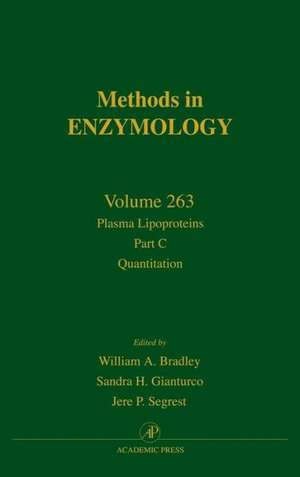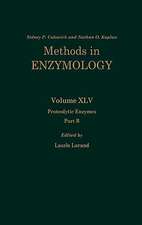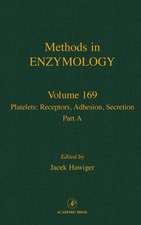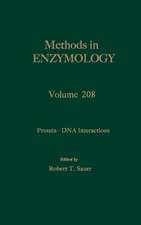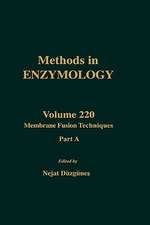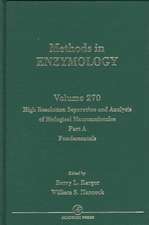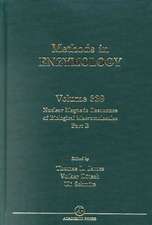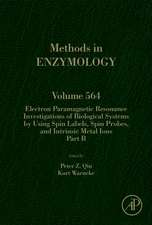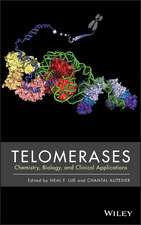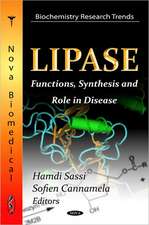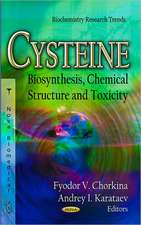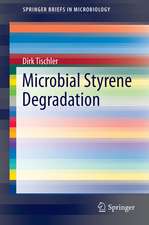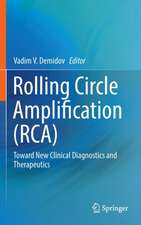Plasma Lipoproteins, Part C: Quantitation: Methods in Enzymology, cartea 263
John N. Abelson, Melvin I. Simon William A. Bradley, Sandra H. Gianturco, Jere P. Segresten Limba Engleză Hardback – 26 ian 1996
- Methods for the quantitation of apolipoproteins related to cardiovascular disease
- Problems of lipoprotein heterogeneity and quantitation
- Apolipoproteins B-100 and B-48, timely because of current interest in post-prandial lipoproteins and their contribution to risk for atherosclerosis and coronary disease
Din seria Methods in Enzymology
- 32%
 Preț: 802.54 lei
Preț: 802.54 lei - 23%
 Preț: 461.36 lei
Preț: 461.36 lei - 23%
 Preț: 460.60 lei
Preț: 460.60 lei - 23%
 Preț: 439.86 lei
Preț: 439.86 lei - 23%
 Preț: 448.15 lei
Preț: 448.15 lei - 23%
 Preț: 451.42 lei
Preț: 451.42 lei - 23%
 Preț: 445.18 lei
Preț: 445.18 lei - 5%
 Preț: 557.15 lei
Preț: 557.15 lei - 23%
 Preț: 450.67 lei
Preț: 450.67 lei - 23%
 Preț: 446.23 lei
Preț: 446.23 lei - 23%
 Preț: 435.87 lei
Preț: 435.87 lei - 23%
 Preț: 445.94 lei
Preț: 445.94 lei - 23%
 Preț: 459.55 lei
Preț: 459.55 lei - 23%
 Preț: 460.02 lei
Preț: 460.02 lei - 23%
 Preț: 456.61 lei
Preț: 456.61 lei - 23%
 Preț: 450.54 lei
Preț: 450.54 lei - 23%
 Preț: 453.47 lei
Preț: 453.47 lei - 5%
 Preț: 565.37 lei
Preț: 565.37 lei - 23%
 Preț: 450.67 lei
Preț: 450.67 lei - 23%
 Preț: 464.33 lei
Preț: 464.33 lei - 23%
 Preț: 441.49 lei
Preț: 441.49 lei - 23%
 Preț: 447.44 lei
Preț: 447.44 lei - 23%
 Preț: 459.13 lei
Preț: 459.13 lei - 23%
 Preț: 450.38 lei
Preț: 450.38 lei - 23%
 Preț: 445.80 lei
Preț: 445.80 lei - 23%
 Preț: 445.35 lei
Preț: 445.35 lei - 23%
 Preț: 442.53 lei
Preț: 442.53 lei - 23%
 Preț: 450.38 lei
Preț: 450.38 lei - 23%
 Preț: 448.60 lei
Preț: 448.60 lei - 23%
 Preț: 447.57 lei
Preț: 447.57 lei - 23%
 Preț: 458.97 lei
Preț: 458.97 lei - 23%
 Preț: 440.90 lei
Preț: 440.90 lei - 23%
 Preț: 448.15 lei
Preț: 448.15 lei - 23%
 Preț: 466.84 lei
Preț: 466.84 lei - 23%
 Preț: 451.42 lei
Preț: 451.42 lei - 23%
 Preț: 453.64 lei
Preț: 453.64 lei - 23%
 Preț: 459.13 lei
Preț: 459.13 lei - 23%
 Preț: 457.49 lei
Preț: 457.49 lei - 23%
 Preț: 447.44 lei
Preț: 447.44 lei - 5%
 Preț: 561.34 lei
Preț: 561.34 lei - 23%
 Preț: 447.57 lei
Preț: 447.57 lei - 23%
 Preț: 453.35 lei
Preț: 453.35 lei - 23%
 Preț: 441.95 lei
Preț: 441.95 lei - 23%
 Preț: 450.38 lei
Preț: 450.38 lei - 23%
 Preț: 449.19 lei
Preț: 449.19 lei - 23%
 Preț: 456.02 lei
Preț: 456.02 lei - 23%
 Preț: 455.11 lei
Preț: 455.11 lei - 23%
 Preț: 455.87 lei
Preț: 455.87 lei - 23%
 Preț: 451.12 lei
Preț: 451.12 lei
Preț: 442.08 lei
Preț vechi: 574.13 lei
-23% Nou
Puncte Express: 663
Preț estimativ în valută:
84.60€ • 88.21$ • 70.31£
84.60€ • 88.21$ • 70.31£
Carte tipărită la comandă
Livrare economică 20 martie-03 aprilie
Preluare comenzi: 021 569.72.76
Specificații
ISBN-13: 9780121821647
ISBN-10: 0121821641
Pagini: 403
Dimensiuni: 152 x 229 x 23 mm
Greutate: 0.72 kg
Editura: ELSEVIER SCIENCE
Seria Methods in Enzymology
ISBN-10: 0121821641
Pagini: 403
Dimensiuni: 152 x 229 x 23 mm
Greutate: 0.72 kg
Editura: ELSEVIER SCIENCE
Seria Methods in Enzymology
Public țintă
Biochemists, biophysicists, molecular biologists, cell biologists, physiologists, clinical chemists, and biomedical researchers.Cuprins
Characterization of Plasma Lipoproteins
W. Patsch and A.M. Gotto, Jr., Apolipoproteins: Pathophysiology and Clinical Implications. P. Alaupovic, Significance of Apolipoproteins for Structure, Function, and Classification of Plasma Lipoproteins.
Apolipoproteins Apolipoprotein B
G.L. Vega and S.M. Grundy, Quantitation of Apolipoprotein B by Chemical Methods. N. Bergeron, L. Kotite, and R.J. Havel, Simultaneous Quantification of Apolipoproteins B-100, B-48, and E Separated by SDS–PAGE. F. Karpe, A. Hamsten, K. Uffelman, and G. Steiner, Apolipoprotein B-48. J.D. Sparks and C.E. Sparks, Chromatographic Method for Isolation and Quantification of Apolipoproteins B-100 and B-48. S.G. Young, E.S. Krul, S. McCormick, R.V. Farese, Jr., and M.F. Linton,Identification and Characterization of Truncated Forms of Apolipoprotein B in Hypobetalipoproteinemia. D.M. Lee, Apolipoprotein B-48: Problems Related to Quantification. R.W. Milne, Immunochemical Separation of Apolipoprotein B-48- and B-100-Containing Lipoproteins.
Apolipoprotein E
E.S. Krul and T.G. Cole, Quantitation of Apolipoprotein E.
Apolipoprotein C
P.W. Connelly, C. Vezina, and G.F. Maguire, Quantification of Apolipoprotein C-II by Immunochemical and Chromatographic Methods. M.L. Kashyap, Immunochemical Methods for Quantification of Human Apolipoprotein C-III.
Apolipoprotein [a]
J.W. Gaubatz, P. Mital, and J.D. Morrisett, Electrophoretic Methods for Quantitation of Lipoprotein [a]. G.M. Fless and M.L. Snyder, Quantitation of Lipoprotein (a) after Lysine-Sepharose Chromatography and Density Gradient Centrifugation. Apolipoprotein A: C.J. Fielding and P.E. Fielding, Two-Dimensional Nondenaturing Electrophoresis of Lipoproteins: Applications to High-Density Lipoprotein Speciation. S.T. Kunitake, P. O'Connor, and J. Naya-Vigne, Heterogeneity of High-Density Lipoproteins and Apolipoprotein A-I as Related to Quantification of Apolipoprotein A-I. G.M. Anantharamaiah and D.W. Garber, Chromatographic Methods for Quantitation of Apolipoprotein A-I. R.B. Weinberg, R.A. Hopkins, and J.B. Jones,Purification, Isoform Characterization, and Quantitation of Human Apolipoprotein A-IV. N.H. Fidge, Immunochemical Methods for Quantification of Apolipoprotein A-IV.
Apolipoprotein J
S.H. Jenkins, W.D. Stuart, L.A. Bottoms, and J.A.K. Harmony, Quantitation of Plasma Apolipoprotein J.
Lipases and Cholesteryl Ester Transfer Protein
R. Potenz, J.-Y. Lo, E. Zsigmond, L.C. Smith, and L. Chan, Human Lipoprotein Lipase: Production in Vitro, Purification, and Generation of Polyclonal Antibody. E. Zsigmond, J.-Y. Lo, L.C. Smith, and L. Chan, Immunochemical Quantitationof Lipoprotein Lipase. A. Bensadoun, Sandwich Immunoassay for Measurement of Human Hepatic Lipase. K.C. Glenn and M.A. Melton, Quantification of Cholesteryl Ester Transfer Protein: Activity and Immunochemical Assay. A. Mitchell and N. Fidge, Determination of Apolipoprotein mRNA Levels by Ribonuclease Protection Assay.
W. Patsch and A.M. Gotto, Jr., Apolipoproteins: Pathophysiology and Clinical Implications. P. Alaupovic, Significance of Apolipoproteins for Structure, Function, and Classification of Plasma Lipoproteins.
Apolipoproteins Apolipoprotein B
G.L. Vega and S.M. Grundy, Quantitation of Apolipoprotein B by Chemical Methods. N. Bergeron, L. Kotite, and R.J. Havel, Simultaneous Quantification of Apolipoproteins B-100, B-48, and E Separated by SDS–PAGE. F. Karpe, A. Hamsten, K. Uffelman, and G. Steiner, Apolipoprotein B-48. J.D. Sparks and C.E. Sparks, Chromatographic Method for Isolation and Quantification of Apolipoproteins B-100 and B-48. S.G. Young, E.S. Krul, S. McCormick, R.V. Farese, Jr., and M.F. Linton,Identification and Characterization of Truncated Forms of Apolipoprotein B in Hypobetalipoproteinemia. D.M. Lee, Apolipoprotein B-48: Problems Related to Quantification. R.W. Milne, Immunochemical Separation of Apolipoprotein B-48- and B-100-Containing Lipoproteins.
Apolipoprotein E
E.S. Krul and T.G. Cole, Quantitation of Apolipoprotein E.
Apolipoprotein C
P.W. Connelly, C. Vezina, and G.F. Maguire, Quantification of Apolipoprotein C-II by Immunochemical and Chromatographic Methods. M.L. Kashyap, Immunochemical Methods for Quantification of Human Apolipoprotein C-III.
Apolipoprotein [a]
J.W. Gaubatz, P. Mital, and J.D. Morrisett, Electrophoretic Methods for Quantitation of Lipoprotein [a]. G.M. Fless and M.L. Snyder, Quantitation of Lipoprotein (a) after Lysine-Sepharose Chromatography and Density Gradient Centrifugation. Apolipoprotein A: C.J. Fielding and P.E. Fielding, Two-Dimensional Nondenaturing Electrophoresis of Lipoproteins: Applications to High-Density Lipoprotein Speciation. S.T. Kunitake, P. O'Connor, and J. Naya-Vigne, Heterogeneity of High-Density Lipoproteins and Apolipoprotein A-I as Related to Quantification of Apolipoprotein A-I. G.M. Anantharamaiah and D.W. Garber, Chromatographic Methods for Quantitation of Apolipoprotein A-I. R.B. Weinberg, R.A. Hopkins, and J.B. Jones,Purification, Isoform Characterization, and Quantitation of Human Apolipoprotein A-IV. N.H. Fidge, Immunochemical Methods for Quantification of Apolipoprotein A-IV.
Apolipoprotein J
S.H. Jenkins, W.D. Stuart, L.A. Bottoms, and J.A.K. Harmony, Quantitation of Plasma Apolipoprotein J.
Lipases and Cholesteryl Ester Transfer Protein
R. Potenz, J.-Y. Lo, E. Zsigmond, L.C. Smith, and L. Chan, Human Lipoprotein Lipase: Production in Vitro, Purification, and Generation of Polyclonal Antibody. E. Zsigmond, J.-Y. Lo, L.C. Smith, and L. Chan, Immunochemical Quantitationof Lipoprotein Lipase. A. Bensadoun, Sandwich Immunoassay for Measurement of Human Hepatic Lipase. K.C. Glenn and M.A. Melton, Quantification of Cholesteryl Ester Transfer Protein: Activity and Immunochemical Assay. A. Mitchell and N. Fidge, Determination of Apolipoprotein mRNA Levels by Ribonuclease Protection Assay.
Recenzii
Praise for the Series
"The Methods in Enzymology series represents the gold-standard." --NEUROSCIENCE
"Incomparably useful." --ANALYTICAL BIOCHEMISTRY
"It is a true 'methods' series, including almost every detail from basic theory to sources of equipment and reagents, with timely documentation provided on each page." --BIO/TECHNOLOGY
"The series has been following the growing, changing and creation of new areas of science. It should be on the shelves of all libraries in the world as a whole collection." --CHEMISTRY IN INDUSTRY
"The appearance of another volume in that excellent series, Methods in Enzymology, is always a cause for appreciation for those who wish to successfully carry out a particular technique or prepare an enzyme or metabolic intermediate without the tiresome prospect of searching through unfamiliar literature and perhaps selecting an unproven method which is not easily reproduced." --AMERICAN SOCIETY OF MICROBIOLOGY NEWS
"If we had some way to find the work most often consulted in the laboratory, it could well be the multi-volume series Methods in Enzymology...a great work." --ENZYMOLOGIA
"A series that has established itself as a definitive reference for biochemists." --JOURNAL OF CHROMATOGRAPHY
"The Methods in Enzymology series represents the gold-standard." --NEUROSCIENCE
"Incomparably useful." --ANALYTICAL BIOCHEMISTRY
"It is a true 'methods' series, including almost every detail from basic theory to sources of equipment and reagents, with timely documentation provided on each page." --BIO/TECHNOLOGY
"The series has been following the growing, changing and creation of new areas of science. It should be on the shelves of all libraries in the world as a whole collection." --CHEMISTRY IN INDUSTRY
"The appearance of another volume in that excellent series, Methods in Enzymology, is always a cause for appreciation for those who wish to successfully carry out a particular technique or prepare an enzyme or metabolic intermediate without the tiresome prospect of searching through unfamiliar literature and perhaps selecting an unproven method which is not easily reproduced." --AMERICAN SOCIETY OF MICROBIOLOGY NEWS
"If we had some way to find the work most often consulted in the laboratory, it could well be the multi-volume series Methods in Enzymology...a great work." --ENZYMOLOGIA
"A series that has established itself as a definitive reference for biochemists." --JOURNAL OF CHROMATOGRAPHY
